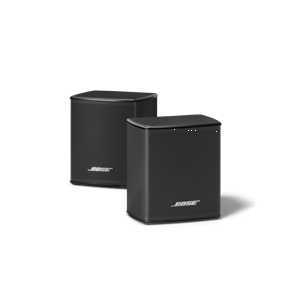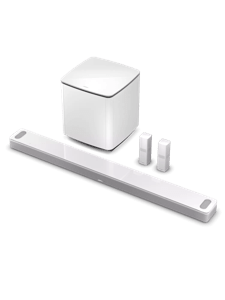Most modern TVs feature thin flat-panel screens, and while the picture quality has improved massively with 4K and 8K screens, there’s little room for speakers, which means you experience poor audio quality. Any home theatre system aims to provide better sound quality and a more exciting audio experience, placing you in the middle of the action.
When you’re looking at options, you’ll come across terms for different types of surround sound, like 5.1 and 7.1. Whether you’re comparing 5.1 vs. 7.1 surround sound, or considering a cutting-edge format like Dolby Atmos®, the goal is to enhance your audiovisual entertainment. As the term surround sound implies, this is done by placing speakers surrounding your viewing position to create an immersive sound stage
What’s the difference between 5.1 and 7.1 sound? It all comes down to the number of speakers. Read on to learn more.
What is 5.1 surround sound?
Any surround sound home theatre setup is designed to be experienced from a fixed listening position, like your favourite spot on the couch, so multiple speakers are necessary to achieve the fully immersive listening experience. A 5.1 surround sound setup has five main speakers, plus a subwoofer for low frequencies. The five main surround sound speakers are left front, centre, right front, left surround, and right surround. There’s also a 5.1 receiver, which includes a built-in amplifier to drive the speakers and the subwoofer.
When reproducing the audio between five speakers and a subwoofer, it’s possible to separate elements like dialogue and sound effects much more easily, resulting in greater clarity. Dialogue tracks can be emphasized through the centre speaker, and other sounds can be positioned and moved between the front and surround speakers during surround sound mixing. To complete the surround sound experience, the subwoofer or bass module (the .1 in the 5.1) handles all the low and sub-bass frequencies far better than regular speakers can, which is great for reproducing sound effects like explosions, earthquakes, vehicle noise, or any other intense sounds with a lot of impact and low frequency content. With the 5.1 combination of five speakers and a subwoofer, you’ll hear and feel everything.
What is 7.1 surround sound?
A 7.1 system has the same five main speakers as a 5.1 system, plus another two surround speakers added for side surround. These extra speakers are positioned between the front and rear speakers, facing inward toward the listening position to help create an even better sense of depth and detail. There was a time when the only way you could experience 7.1 surround sound was by going to the cinema, but now you can enjoy the same enhanced audio at home with the right 7.1 setup.
The differences between 5.1 vs. 7.1
The number of speakers and the type of receiver are the only differences between a 5.1 and a 7.1 system. A 5.1 system is usually enough for a standard living room size, while a 7.1 system (with its additional surround speakers) may be better for larger living rooms, a dedicated home theatre room, or an audiovisual presentation suite. It also depends on the amount of furnishings and available space. For a large, open room, a 7.1 system is the best option. Crowding a 7.1 system into a small room may actually make it harder to hear sounds from the front speakers, as there could be too many surround speakers too close together.
Another consideration when choosing between 5.1 or 7.1 is the cost. A 7.1 system will often be more expensive, though prices vary between configurations. 5.1 packages are often easier to find and more commonly sold as an off-the-shelf solution.
Additional surround sound options
After 5.1, 6.1 surround sound became available as well, with a single surround speaker to the rear of the listening position, as opposed to the two that a 7.1 system offers. However, 6.1 has become obsolete due to the 7.1.
Dolby Atmos is the latest development to come to the audio space after surround sound. Dolby Atmos adds height channels, played back via upward-firing speakers reflecting sound from the ceiling, or by ceiling-mounted speakers. Adding height channels enables Dolby Atmos to create a truly immersive 3D sound experience, with up to 118 separate objects moving in any direction left to right, front to back, and up and down through 3D space, which is how we naturally perceive sound in the real world.
There are many types of Dolby Atmos speaker setups, ranging from 5.1 and 7.1 to 9.1 configurations and beyond. Some systems are configured as 5.1.2, 7.1.2, or 9.1.2, where the .2 represents height speakers.
Soundbars like the Bose Smart Ultra Soundbar feature front, side, and upward-firing speakers all rolled into one stylish unit, connecting to your TV via an HDMI cable. A bass module and surround speakers can be added wirelessly to provide an easy, powerful home theatre solution. Bose soundbars can stream lossless audio, with Dolby Atmos capability. They can also upmix stereo content into Atmos-like sound using Bose TrueSpace technology.
Now that you understand the various surround sound formats, you’ll be able to find the perfect setup for your epic home theatre system.








